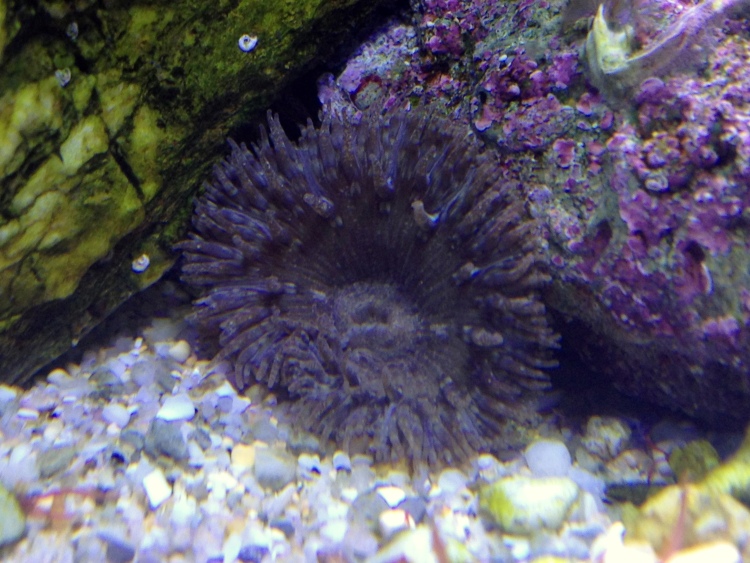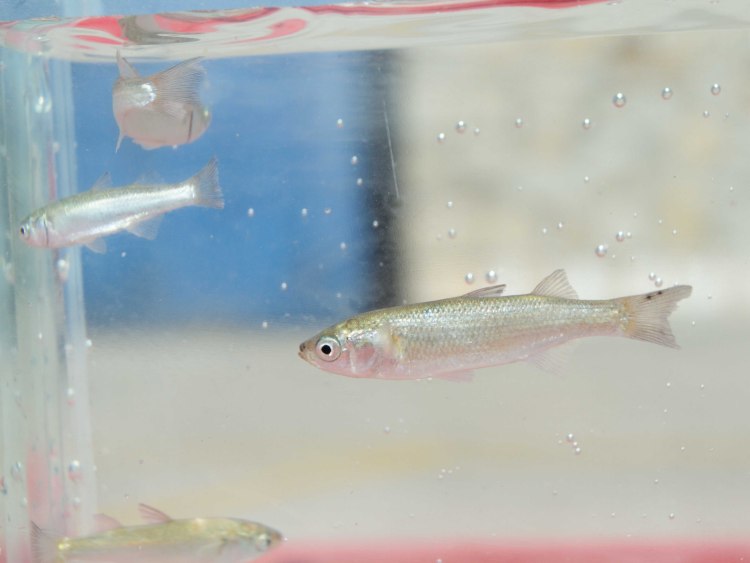Long time no post, just been too busy! The aquarium is doing reasonably well at the moment, especially considering the fact that I have not done any water changes since the last update and I have added a bunch of new organisms. I have added two Beadlet anemones Actinia equina. They are a dullish brown (except for a nice blue band around the base); I have not found the bright red or green individuals yet. Very similar but more striking are Strawberry anemones Actinia fragacea of which I have collected three. They are voracious, I could easily feed them a shrimp a day. The same goes for the Sea scorpion. I am afraid of sticking my hand in now as it comes after me! Time to let this buddy go. This will also give me the opportunity to add some other things such as squat lobsters. I have taken a break from experimenting with seaweeds and am focusing on anemones instead. I have added a bunch of small Plumose anemones Metridium senile that I scraped of the side of a pontoon. Weird fellas, they can fill up with water to be quite large, or just reduce to a crumpled little pancake. I have four white ones; I could only find very small ones of the orange variety and these were all devoured by Cushion stars (interesting). I’d like to have a large orange one as well, but I have to wait half a year until I can go diving again (they are very common in deeper water).
I have taken a break from experimenting with seaweeds and am focusing on anemones instead. I have added a bunch of small Plumose anemones Metridium senile that I scraped of the side of a pontoon. Weird fellas, they can fill up with water to be quite large, or just reduce to a crumpled little pancake. I have four white ones; I could only find very small ones of the orange variety and these were all devoured by Cushion stars (interesting). I’d like to have a large orange one as well, but I have to wait half a year until I can go diving again (they are very common in deeper water).
 On the sheltered, silty shore of Flushing I found two small anemones attached to rock and half buried in the maerl sand. My excellent Seasearch Sea Anemones and Corals guide told me they were a Daisy anemone Cereus pedunculatus (uniform greay with many very short tentacles) and a Red speckled anemone Anthopleura balli (purplish and speckled, for a better picture of a different colour variant see this old post). Both quickly half buried/half nestled themselves under a rock so only the tentacles and the mouth are visible. They take pieces of shrimp and so hopefully they’ll be able to grow; these species should reach a decent size:
On the sheltered, silty shore of Flushing I found two small anemones attached to rock and half buried in the maerl sand. My excellent Seasearch Sea Anemones and Corals guide told me they were a Daisy anemone Cereus pedunculatus (uniform greay with many very short tentacles) and a Red speckled anemone Anthopleura balli (purplish and speckled, for a better picture of a different colour variant see this old post). Both quickly half buried/half nestled themselves under a rock so only the tentacles and the mouth are visible. They take pieces of shrimp and so hopefully they’ll be able to grow; these species should reach a decent size: 
 My friend marine biologist Chris gave me a snakelocks anemone that he had cured from its symbiotic algae. A very cool, bright white individual but it has returned to its original purplish colour so it must have taken up symbionts again. The snakelocks I already had, grew big, split into two and grew some more. Interestingly, one of the individuals seems to be turning from the green- to the purple colour variety:
My friend marine biologist Chris gave me a snakelocks anemone that he had cured from its symbiotic algae. A very cool, bright white individual but it has returned to its original purplish colour so it must have taken up symbionts again. The snakelocks I already had, grew big, split into two and grew some more. Interestingly, one of the individuals seems to be turning from the green- to the purple colour variety: So six anemone species in all. I would really like to have some Dahlia anemones, they are very colourful, large, and not uncommon (old pic here). I need to go anemone hunting at a good low tide soon (I have not been out in ages).
So six anemone species in all. I would really like to have some Dahlia anemones, they are very colourful, large, and not uncommon (old pic here). I need to go anemone hunting at a good low tide soon (I have not been out in ages).
I had the Chryseminia seaweed growing attached to the Tunze for a while and it worked OK, but it looks a bit messy and so I will remove it. However, I see that little Chryseminia plants have started to grow from the rock in many places (see top picture). I have to give the glass a weekly clean (with a tooth brush) and the rocks have turned a bit too greenish recently. I have noticed however that near the Snakelocks anemones, tufts of filamentous algae have appeared, as the grazers do not want to come too close to their tentacles (this reminds me of a work by an ecologist friend of mine who studies how seedlings can be protected from grazers when growing close to thorny shrubs, I’ll have to tell him of this observation!).
There has been some snail mortality. I mainly have Grey top shells but there are less than half of them left. I do not know why, part might be predation (which is not all bad as at least they serve as food for other inhabitants). I need to collects some more in any case. The Netted dog whelks are doing well. They are usually hidden below the sand, but as soon as they smell a defrosted shrimp, they come up like a Shai-Hulud. Their plowing through the sand is definitely good in preventing mats of diatoms to appear. Their little cousins the Thicklipped dog whelks are also doing fine. They tend to creep up the Daisy anemone to steal its food. I still have a Sting winkle Ocenebra erinacea which moves slowly but is very pretty. There are a variety of other species such as Blacklined- and Rough periwinkles. The best species however are the truly sublittoral large Turban top shells Gibbula magus (some of which have died as well, one of the shells has been taken over by a hermit crab, wich are also doing fine):

 Poor thing (although it had eaten 22 of my mullet so it works both ways I guess…). The good thing was that I could try keeping some other fish again. Using my net, I caught some Two-spotted gobies as well as a Common goby Pomatoschistus microps (I think, there are some very similar species) and a Goldsinny wrasse Ctenolabrus rupestris. The total tally from netting off the Flushing quay is now eleven fish species, not bad. The Goldsinny swims around the tank a lot and does some digging; it seems to be a more interesting fish to watch than the Corkwing:
Poor thing (although it had eaten 22 of my mullet so it works both ways I guess…). The good thing was that I could try keeping some other fish again. Using my net, I caught some Two-spotted gobies as well as a Common goby Pomatoschistus microps (I think, there are some very similar species) and a Goldsinny wrasse Ctenolabrus rupestris. The total tally from netting off the Flushing quay is now eleven fish species, not bad. The Goldsinny swims around the tank a lot and does some digging; it seems to be a more interesting fish to watch than the Corkwing: The Turban top shells Gibbula magus are very nice to watch (the Grey topshell Gibbula cinerarea gives a sense of scale). I found a Sea urchin Psammechinus miliaris and decided to try it out. It spends half its time under the gravel and pops up here and there with shells and pebbles attached to it. Let’s see what it does! Lastly a picture of the tank. I had attached a young Sugar kelp Saccharina latissima to the tunze pump with an elastic band and now it has attached itself to the plastic.
The Turban top shells Gibbula magus are very nice to watch (the Grey topshell Gibbula cinerarea gives a sense of scale). I found a Sea urchin Psammechinus miliaris and decided to try it out. It spends half its time under the gravel and pops up here and there with shells and pebbles attached to it. Let’s see what it does! Lastly a picture of the tank. I had attached a young Sugar kelp Saccharina latissima to the tunze pump with an elastic band and now it has attached itself to the plastic.
























